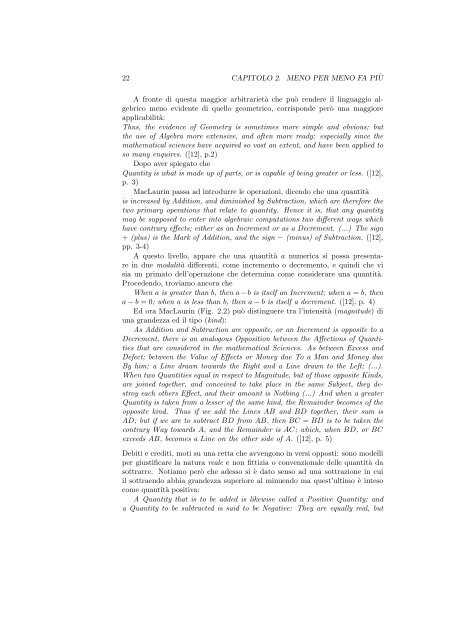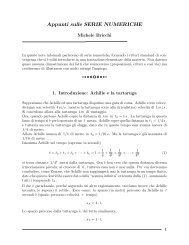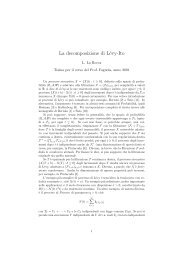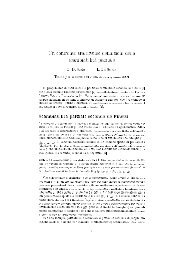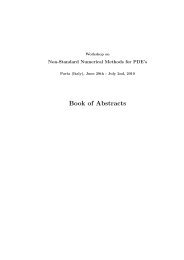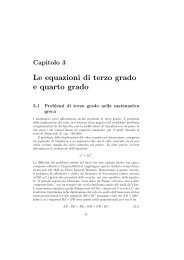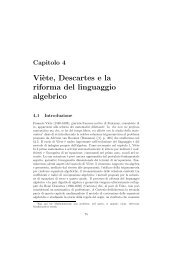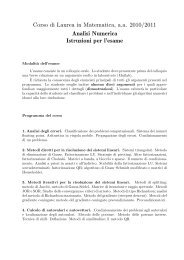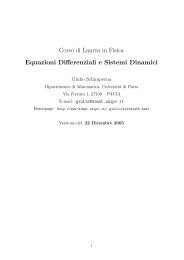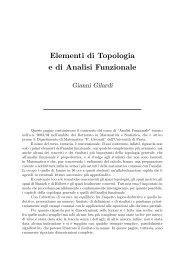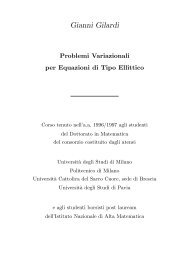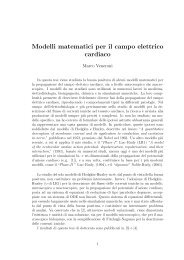Capitolo II - Dipartimento di Matematica
Capitolo II - Dipartimento di Matematica
Capitolo II - Dipartimento di Matematica
Create successful ePaper yourself
Turn your PDF publications into a flip-book with our unique Google optimized e-Paper software.
22 CAPITOLO 2. MENO PER MENO FA PIÙ<br />
A fronte <strong>di</strong> questa maggior arbitrarietà che può rendere il linguaggio algebrico<br />
meno evidente <strong>di</strong> quello geometrico, corrisponde però una maggiore<br />
applicabilità:<br />
Thus, the evidence of Geometry is sometimes more simple and obvious; but<br />
the use of Algebra more extensive, and often more ready: especially since the<br />
mathematical sciences have acquired so vast an extent, and have been applied to<br />
so many enquires. ([12], p.2)<br />
Dopo aver spiegato che<br />
Quantity is what is made up of parts, or is capable of being greater or less. ([12],<br />
p. 3)<br />
MacLaurin passa ad introdurre le operazioni, <strong>di</strong>cendo che una quantità<br />
is increased by Ad<strong>di</strong>tion, and <strong>di</strong>minished by Subtraction, which are therefore the<br />
two primary operations that relate to quantity. Hence it is, that any quantity<br />
may be supposed to enter into algebraic computations two <strong>di</strong>fferent ways which<br />
have contrary effects; either as an Increment or as a Decrement. (...) The sign<br />
+ (plus) is the Mark of Ad<strong>di</strong>tion, and the sign − (minus) of Subtraction. ([12],<br />
pp. 3-4)<br />
A questo livello, appare che una quantità a numerica si possa presentare<br />
in due modalità <strong>di</strong>fferenti, come incremento o decremento, e quin<strong>di</strong> che vi<br />
sia un primato dell’operazione che determina come considerare una quantità.<br />
Procedendo, troviamo ancora che<br />
When a is greater than b, then a−b is itself an Increment; when a = b, then<br />
a−b = 0; when a is less than b, then a−b is itself a decrement. ([12], p. 4)<br />
Ed ora MacLaurin (Fig. 2.2) può <strong>di</strong>stinguere tra l’intensità (magnitude) <strong>di</strong><br />
una grandezza ed il tipo (kind):<br />
As Ad<strong>di</strong>tion and Subtraction are opposite, or an Increment is opposite to a<br />
Decrement, there is an analogous Opposition between the Affections of Quantities<br />
that are considered in the mathematical Sciences. As between Excess and<br />
Defect; between the Value of Effects or Money due To a Man and Money due<br />
By him; a Line drawn towards the Right and a Line drawn to the Left; (...).<br />
When two Quantities equal in respect to Magnitude, but of those opposite Kinds,<br />
are joined together, and conceived to take place in the same Subject, they destroy<br />
each others Effect, and their amount is Nothing (...) And when a greater<br />
Quantity is taken from a lesser of the same kind, the Remainder becomes of the<br />
opposite kind. Thus if we add the Lines AB and BD together, their sum is<br />
AD; but if we are to subtract BD from AB, then BC = BD is to be taken the<br />
contrary Way towards A, and the Remainder is AC; which, when BD, or BC<br />
exceeds AB, becomes a Line on the other side of A. ([12], p. 5)<br />
Debiti e cre<strong>di</strong>ti, moti su una retta che avvengono in versi opposti: sono modelli<br />
per giustificare la natura reale e non fittizia o convenzionale delle quantità da<br />
sottrarre. Notiamo però che adesso si è dato senso ad una sottrazione in cui<br />
il sottraendo abbia grandezza superiore al minuendo ma quest’ultimo è inteso<br />
come quantità positiva:<br />
A Quantity that is to be added is likewise called a Positive Quantity; and<br />
a Quantity to be subtracted is said to be Negative: They are equally real, but


